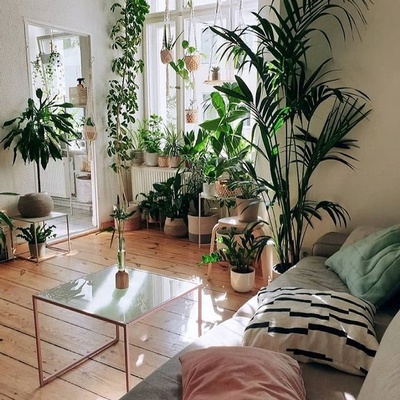Have You Seen the Light? A Guide to Understanding Lighting Conditions in Your Home.

Image by @j9s_jungle
To ensure the success of your plants, it's essential to first understand your specific lighting conditions. Oftentimes, when we hear from new plant parents that their plant is struggling, the issue is that it is not getting the right amount of light.
If we think back to elementary school, we remember that plants make their own food through a process called photosynthesis. This means that they get their energy from sunlight. But we often don't realize that plants have evolved to flourish in a variety of lighting conditions. Some prefer full sun and would die in low light, while others thrive in shade and would quickly burn in full sun.
You’ve no doubt heard the terms bright, indirect light, full sun, or medium-low light. But what does that mean? You may have even been asked which directions your windows face while in our shop. We hope to help you identify the different types of light you have so you can choose the perfect plant for that spot.

Image by @aeillie_daily
Full sun:
This is pretty self-explanatory. Full sun is the most amount of light. This strong light likely means that you have a skylight, or get afternoon or evening sun from a south or west-facing window. Plants that thrive in this intensity of light have evolved to be tough to avoid losing extra water or being sunburnt. Think of cacti and succulents living in the desert. Or the thick fleshy leaves of hoyas. Some other full-sun plants are birds of paradise, ponytail palms, rubber trees, crotons, and citrus.

Image by @ewa_tomko
Bright, Indirect Light:
By far the type of light that the largest amount of houseplants appreciate. This means a spot where there is a lot of bright light, but it does not get direct sunbeams. In nature you can think of this as filtered or dappled light coming through the leaves of the treetops to the forest floor. Here in the Northern Hemisphere, light coming from the east or north is gentle, so you could put plants that want bright-indirect light in an east or north-facing window. If you have a south or west-facing window, you could simply move the plant a few feet away from that window to achieve bright, indirect light.
The plants that prefer bright, indirect light are too numerous to mention, but some crowd favourites are fiddle leaf figs, dracaenas, philodendrons, and anthuriums.

Image by @jungleva
Medium to Low Light:
We consider low light to be a spot that you could still read a book in for a few hours each day without needing to turn on a light. Plants that evolved to thrive in low light are usually found on the forest floor where sunlight almost never reaches. Plants like ferns, palms, peperomias, calatheas, aglaonemas, peace lilies, and cast-iron plants. Of course the most popular and reliable plants for low light are sansevieria (snake plants) and ZZ plants.
It's important to remember that low light does not mean no light as all plants need light to survive. Some will just be able to die slower and look better as they decline.
How to decrease your light:
Too much light? What a problem to have! Consider getting plants that can tolerate brighter light, or soften the light from a west or south-facing window with a sheer curtain. You can also pull your plants a few feet back from the window to achieve bright, indirect light.
How to increase your light:
Maybe you have a windowless bathroom or live in a basement apartment. Or, like many Toronto homes, you have windows in the front and back of your home but it gets a little darker through the middle. There is always a way to increase the amount of light you get. You could move plants closer to the window, remove window coverings, or heck, even wash your windows. Believe us, it helps.
Remember that light-coloured walls reflect more light than darker walls and so light tints can allow rooms to be brighter. A mirror could also be used to bounce light into a darker area.
But probably the easiest way to add more light is through grow lights. Grow lights come in a variety of styles, qualities, and price ranges. Some are simply full-spectrum bulbs that can be screwed into an existing lamp or light fixture. Others may come as a system that can be mounted under a shelf or hung above your plants. Some give off a purple hue while others are white. You can choose which best suits your budget, aesthetic style, and specific needs. Grow lights are an excellent way to supplement light during darker winter months when natural light decreases.
So what's the takeaway? Choosing the right plant for the type of light that you have will set you up for success. But understand that you can always modify the amount of light you get. Light is a fundamental part of your plants’ survival, so let’s be mindful of where we place our cherished friends.